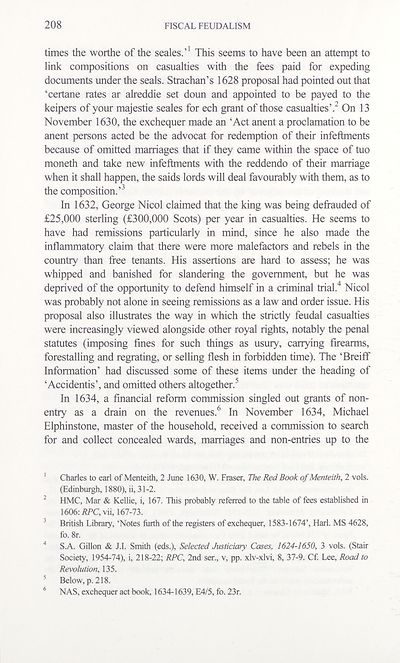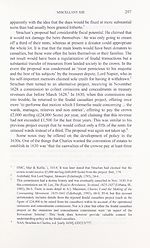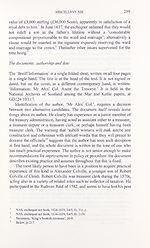Series 5 > Miscellany [of the Scottish History Society] XIII
(223) Page 208
Download files
Complete book:
Individual page:
Thumbnail gallery: Grid view | List view

208
FISCAL FEUDALISM
times the worthe of the seales.’1 This seems to have been an attempt to
link compositions on casualties with the fees paid for expeding
documents under the seals. Strachan’s 1628 proposal had pointed out that
‘certane rates ar alreddie set doun and appointed to be payed to the
keipers of your majestic seales for ech grant of those casualties’.2 On 13
November 1630, the exchequer made an ‘Act anent a proclamation to be
anent persons acted be the advocat for redemption of their infeftments
because of omitted marriages that if they came within the space of tuo
moneth and take new infeftments with the reddendo of their marriage
when it shall happen, the saids lords will deal favourably with them, as to
the composition.’3
In 1632, George Nicol claimed that the king was being defrauded of
£25,000 sterling (£300,000 Scots) per year in casualties. He seems to
have had remissions particularly in mind, since he also made the
inflammatory claim that there were more malefactors and rebels in the
country than free tenants. His assertions are hard to assess; he was
whipped and banished for slandering the government, but he was
deprived of the opportunity to defend himself in a criminal trial.4 Nicol
was probably not alone in seeing remissions as a law and order issue. His
proposal also illustrates the way in which the strictly feudal casualties
were increasingly viewed alongside other royal rights, notably the penal
statutes (imposing fines for such things as usury, carrying firearms,
forestalling and regrating, or selling flesh in forbidden time). The ‘Breiff
Information’ had discussed some of these items under the heading of
‘Accidentis’, and omitted others altogether.5
In 1634, a financial reform commission singled out grants of non¬
entry as a drain on the revenues.6 In November 1634, Michael
Elphinstone, master of the household, received a commission to search
for and collect concealed wards, marriages and non-entries up to the
1 Charles to earl of Menteith, 2 June 1630, W. Fraser, The Red Book of Menteith, 2 vols.
(Edinburgh, 1880), ii, 31-2.
2 HMC, Mar & Kellie, i, 167. This probably referred to the table of fees established in
1606: RPC, vii, 167-73.
3 British Library, ‘Notes furth of the registers of exchequer, 1583-1674’, Harl. MS 4628,
fo. 8r.
4 S.A. Gillon & J.I. Smith (eds.). Selected Justiciary Cases, 1624-1650, 3 vols. (Stair
Society, 1954-74), i, 218-22; RPC, 2nd ser., v, pp. xlv-xlvi, 8, 37-9. Cf. Lee, Road to
Revolution, 135.
5 Below, p. 218.
6 NAS, exchequer act book, 1634-1639, E4/5, fo. 23r.
FISCAL FEUDALISM
times the worthe of the seales.’1 This seems to have been an attempt to
link compositions on casualties with the fees paid for expeding
documents under the seals. Strachan’s 1628 proposal had pointed out that
‘certane rates ar alreddie set doun and appointed to be payed to the
keipers of your majestic seales for ech grant of those casualties’.2 On 13
November 1630, the exchequer made an ‘Act anent a proclamation to be
anent persons acted be the advocat for redemption of their infeftments
because of omitted marriages that if they came within the space of tuo
moneth and take new infeftments with the reddendo of their marriage
when it shall happen, the saids lords will deal favourably with them, as to
the composition.’3
In 1632, George Nicol claimed that the king was being defrauded of
£25,000 sterling (£300,000 Scots) per year in casualties. He seems to
have had remissions particularly in mind, since he also made the
inflammatory claim that there were more malefactors and rebels in the
country than free tenants. His assertions are hard to assess; he was
whipped and banished for slandering the government, but he was
deprived of the opportunity to defend himself in a criminal trial.4 Nicol
was probably not alone in seeing remissions as a law and order issue. His
proposal also illustrates the way in which the strictly feudal casualties
were increasingly viewed alongside other royal rights, notably the penal
statutes (imposing fines for such things as usury, carrying firearms,
forestalling and regrating, or selling flesh in forbidden time). The ‘Breiff
Information’ had discussed some of these items under the heading of
‘Accidentis’, and omitted others altogether.5
In 1634, a financial reform commission singled out grants of non¬
entry as a drain on the revenues.6 In November 1634, Michael
Elphinstone, master of the household, received a commission to search
for and collect concealed wards, marriages and non-entries up to the
1 Charles to earl of Menteith, 2 June 1630, W. Fraser, The Red Book of Menteith, 2 vols.
(Edinburgh, 1880), ii, 31-2.
2 HMC, Mar & Kellie, i, 167. This probably referred to the table of fees established in
1606: RPC, vii, 167-73.
3 British Library, ‘Notes furth of the registers of exchequer, 1583-1674’, Harl. MS 4628,
fo. 8r.
4 S.A. Gillon & J.I. Smith (eds.). Selected Justiciary Cases, 1624-1650, 3 vols. (Stair
Society, 1954-74), i, 218-22; RPC, 2nd ser., v, pp. xlv-xlvi, 8, 37-9. Cf. Lee, Road to
Revolution, 135.
5 Below, p. 218.
6 NAS, exchequer act book, 1634-1639, E4/5, fo. 23r.
Set display mode to:
![]() Universal Viewer |
Universal Viewer | ![]() Mirador |
Large image | Transcription
Mirador |
Large image | Transcription
Images and transcriptions on this page, including medium image downloads, may be used under the Creative Commons Attribution 4.0 International Licence unless otherwise stated. ![]()
| Scottish History Society volumes > Series 5 > Miscellany [of the Scottish History Society] XIII > (223) Page 208 |
|---|
| Permanent URL | https://digital.nls.uk/127316205 |
|---|
| Description | Over 180 volumes, published by the Scottish History Society, containing original sources on Scotland's history and people. With a wide range of subjects, the books collectively cover all periods from the 12th to 20th centuries, and reflect changing trends in Scottish history. Sources are accompanied by scholarly interpretation, references and bibliographies. Volumes are usually published annually, and more digitised volumes will be added as they become available. |
|---|


